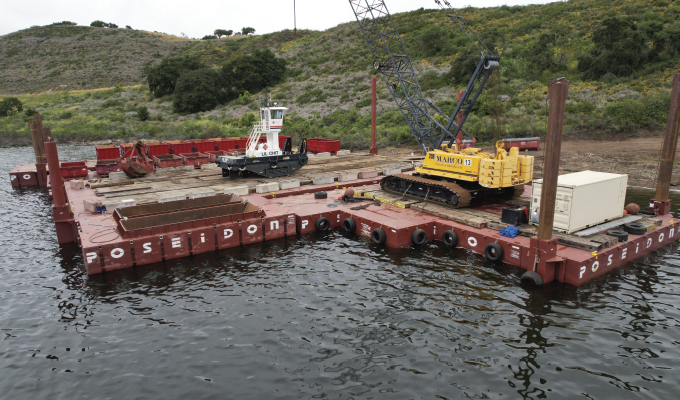When the word “barge” is uttered in a sentence, most people have visions of large river vessels filled with grain or coal, perhaps being pushed by a large tug on the Mighty Mississippi River. Add the word “sectional” and people normally raise an eyebrow. They fail to make the connection between the word “sectional” and “barge”.
What is a sectional barge and what are its benefits?
A sectional barge is one piece of a complete barge system composed of various sections of interlocking floatation barges to create a larger platform. Once assembled, these platforms can be used for many things: work decks for scaffolding, temporary dock systems, transportation decks, ferries, dredging operations, material platforms, and crane decks. That’s just to name a few.
Sectional Barges are typically constructed from steel and are available in a variety of sizes and heights to accommodate the different challenges often found in marine construction and infrastructure development. The amount of weight that can be supported by the barge is typically directly proportional to the depth of the barge. A shallow barge (3-4 ft hull depth) is capable of supporting much less weight safely than a deeper barge (10 ft hull). Deeper barges require less square footage to support overall weight safely.
FACTORS TO CONSIDER
Supporting weight isn’t the only factor to consider when putting together a sectional barge platform. There must be consideration on how the deck will be used in a project, and the platform must provide adequate stability for the job. If a crane is to be used, the weight of the crane and accessories must be accounted for, but also boom length, max pick weight, and the pick radius. All of this factors into the success of the intended purpose of using the sectional barge platform on a project.
THE BARGE ADVANTAGE
Another key advantage sectional barges provide over traditional river barges, is that sectional barges can be used on non-navigable waterways that other equipment cannot. Traditional river barges cannot always access certain rivers, lakes, or reservoirs. Since sectional barges are transportable via over the road truck, they can access all these inland waterways. The truck delivers the sectional barges to the jobsite, a crane removes them from the truck, they are placed in the water and connected together. These sections are assembled according to a pre-determined layout and then the equipment to perform the project is loaded.
Traditional river barges are also rectangular in shape and that is their permanent position. When a customer needs a barge, they are forced to adapt to the barge that is available. Sectional barges allow flexibility in configurations. Sections can be moved around to maximize stability while keeping the deck as manageable as possible. They can be arranged to fit into oddly shaped areas to provide platforms for employees to work on.
CLOSING THOUGHT
Sectional barges provide flexibility, and endless options customers need to be successful on their projects by getting their equipment out into the middle of waterways where the work needs to happen. Some companies choose to add this valuable resource to their equipment fleet as a full-time resource. Others choose to rent for the short while that they may need them. Either way having the versatility of a sectional barge allows these customers to pursue business that they would not be able to perform any other way.
For More Information:
Poseidon, LLC d/b/a Poseidon Barge is a sectional barge manufacturer that rents and sells equipment for the marine industry. Poseidon’s corporate headquarters is in Berne, Indiana. For more information, call 866.992.2743, or visit www.poseidonbarge.com.
Modern Contractor Solutions, August 2023
Did you enjoy this article?
Subscribe to the FREE Digital Edition of Modern Contractor Solutions magazine.



